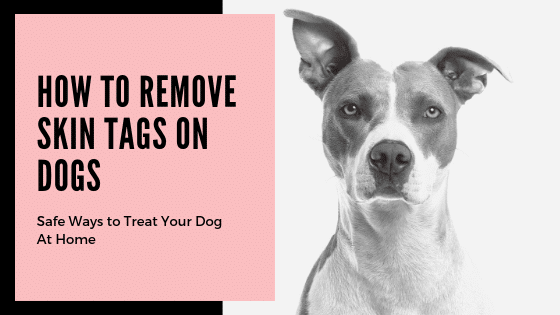Safe And Natural Ways to Treat Your Dog At Home
Skin tags are common on human people (muggles?!), but did you know that skin tags on dogs are also common?

What Are Skin Tags?
They are benign growths that are generally skin-colored and are small bulbs made up of loose skin. In humans, they are usually about the size of a small pencil eraser. While most skin tags remain small, others may grow to the size of a standard grape.
Proportionately the same is true for our canine friends.

Skin tags are generally harmless growths. Most dogs will develop one or two skin tags during their lifetime, but it is also not unusual for some to develop hundreds of them. They develop equally in male and female dogs. And just like with humans, skin tags seem to be more frequent in dogs who are overweight.
While some skin tags may fall off without being cut or frozen off, most of them are persistent and will remain unless they are physically removed. In the world of medicine, the correct term for a skin tag is acrochordon.
Can Dogs Get Skin Tags And What Are The Causes?

While there is no single established reason why skin tags develop on dogs, there are many reasons veterinarians suspect. Here are some of the most common reasons:
Your Pet’s Age
In humans, skin tags are frequently a very normal part of getting older. The same is true for your furry friend.
Should these be a matter of concern? Not really. Skin tags that develop on the chest and stomach of your dog should cause no problem and may best be left alone.

If skin tags develop around your dog’s eyes, in the tender under-arm area, or around his muzzle, however, you may want to have him looked at by a vet.
A word to the wise: Do not attempt to remove skin tags in these delicate areas without medical supervision.
Exposure To Elements
Your pet’s environment is still another possible contributor to skin tags in dogs.
Dogs that spend a great deal of time outdoors are frequently exposed to garden chemicals and pesticides. This is especially true for dogs that hang out in the backyard. Home based chemicals and pesticides may irritate the skin and provoke tags and other growths.
Genetics

We know that medical conditions can be passed down from generation to generation in humans. The same is true for dogs. If your puppy develops skin tags, there is a better than average chance that their parents or grandparents had developed them also.
Genetics, therefore, may be one of the most obvious reasons your dog develops skin tags.
Vermin & Parasites
Obviously, you try hard to prevent fleas, ticks and lice from gaining access to and attacking your pet. Even so, sometimes it is impossible to keep your animal parasite free.
Skin tags may be caused by vermin such as fleas, mites, ticks, etc. Frequently these may appear after your dog has been treated for parasites.
Hygiene
Not unlike their human counterparts, our canine friends require good hygiene. Many experts feel skin tags on dogs are a result of the animal not being bathed often enough. The dirt and oil that develops and builds up in and under a dog’s coat may encourage their development.
Skin Care Products & Shampoos
Just like humans, dogs may have allergic reactions to various shampoos and skin care products. It is always a good idea to use shampoos and other product that are hypoallergenic and contain no substances that may cause irritation to your dog’s skin.
What should you do when your dog develops a skin tag?
Some dog owners become anxious and upset when they discover any type of skin growth on their pet. Often, they may feel these are dangerous and may indicate some form of cancer.
Remember that most skin tags, including those on dogs, are benign. There are, however, other skin growths, including lumps, that may be more ominous. For this reason, it is always a good idea to have your animal checked by your vet.
Skin tags on dogs are most often painless. Check your dog by very gently touching the growth to see if your animal shows signs of discomfort. If your pet gives you no obvious reaction by whimpering or trying to get away from your touch, the chances are good you are dealing with a simple skin tag.
On the other hand, if your dog displays a sensitivity or displays signs of pain or discomfort, get hold of your vet to have the animal thoroughly examined.
While skin tags are generally painless for dogs, some more potentially dangerous growths will often cause your animal pain or discomfort when touched.
A skin tag on a dog is generally only a few millimeters long and will most often be the color of your dog’s skin. If you are familiar with skin tags in humans, be assured they look very much the same on your pet.
As a rule, however, there are mast-cell tumors that can closely resemble skin tags. These may develop at any stage of your dog’s life – even when your dog is young. Note that these normally appear on the dog’s underside.
If you are not sure what skin tags are or how they should appear, then you should take a look at photos of skin tags on dogs.
How To Remove Skin Tags On Your Dog At Home
Once you are certain you are dealing with a doggie skin tag, you may choose to remove it.
There are a couple of basic ways to remove skin tags on dogs. Each requires specific supplies. It would also be good to have someone help you who is familiar to your dog. While you are removing the skin tag, your partner may be able to keep your pet calm and relaxed.
Tying Off The Skin Tag
This procedure requires rubbing alcohol, a good pair of sterilized scissors, a length of dental floss (you may also use fishing line) and new razor. It would also be good to have a cone collar to prevent your pet from biting or chewing at the skin tag.
Many pet owners choose not to have to cut off the skin tag. One of the best ways to prevent this is by tying off the unwanted growth. This home remedy seems to be most successful when the skin tag is longer.
Often there is a big piece of skin that looks somewhat like a small piece of string, with the actual tag at the end. This allows you to hold the tag between two fingertips.
While one individual sets up the materials, the other should gently pet the dog and put it at ease. Then, when the dog must be held down, it will be more accepting.
First you need to shave off any hair right around the skin tag. Once that is done, you need to use the rubbing alcohol to completely disinfect the area.
Now tear off approximately 12 inches of dental floss and tightly wrap it around the bottom part of the skin tag. While you are not injuring your pet, he may at first whimper and indicate he is in some discomfort. After a minute or two your dog’s mild panic should pass as he gets used to the feeling.
The next step is to put the cone collar around your pet’s neck. This will prevent him from nibbling away at the string.
You can expect the skin tag to fall off after about three or four days. The growth should not return after this procedure.
Cutting Off The Skin Tag
This remedy requires cotton balls, rubbing alcohol, a razor, iodine, bandages and a pair of mayo scissors. You should also have a bowl filled with water and another bowl for the scissors. You also will need a soldering pen, a new razor, and some gauze bandages.
This procedure removes skin tags by simply cutting the growth off.
Start by shaving hair off the area around the skin tag. Disinfect the scissors in the rubbing alcohol. Dab rubbing alcohol around the skin tag.
Next, mix iodine in the water (make a 10% solution) and dab it onto the skin tag.
Next, cut the skin tag at its base and quickly cauterize the cut with a soldering pen. Place the gauze bandage onto the affected area. Make certain it is completely covered and secure.
Then simply wait for it to heal.
The Most Recommended Procedure
The safest and best recommendation we can make is for you to simply leave the skin tag on your dog alone.
Chances are your vet has confirmed that the skin tag will not harm your pet. Therefore, there is no good reason (other than cosmetic) to remove it!
Remember, skin tags on dogs are not uncommon. Most often they are benign growths that do not cause any harm or discomfort to your pet. Therefore, most vets will recommend that they be left alone. Keep in mind that anything you do to remove skin tags will cause your dog some level of discomfort. Therefore, why not do the most loving thing and leave them alone!


